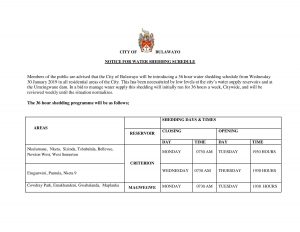The Bulawayo City Council (BCC) has introduced a 36 hour water rationing schedule in all residential suburbs.
The move according to the local authority is necessitated by low levels at the city’s water supply reservoirs and at Umzingwane dam.
“Members of the public are advised that the City of Bulawayo will be introducing a 36 hour water shedding schedule from Wednesday 30 January 2019 in all residential areas of the City,” the City`s Town Clerk Christopher Dube, said in a statement Wednesday.
“This has been necessitated by low levels at the city’s water supply reservoirs and at the Umzingwane dam. In a bid to manage water supply this shedding will initially run for 36 hours a week, Citywide, and will be reviewed weekly until the situation normalizes”.
Dube urged residents to use water sparingly as efforts are being made to avail adequate water to them.
The water shedding schedule is posted below:



